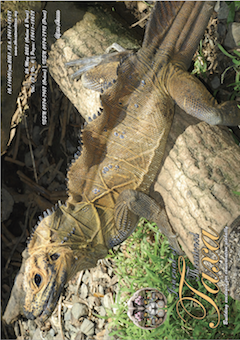Mating behavior of Eastern Spotted Skunk Spilogale putorius Linnaeus, 1758 (Mammalia: Carnivora: Mephitidae) revealed by camera trap in Texas, USA
DOI:
https://doi.org/10.11609/jott.6642.13.6.18660-18662Keywords:
behavior, camera trap, conservation, courtship, demography, Eastern Spotted Skunk, Fort Hood, population, reproduction, Spilogale putoriusAbstract
Eastern Spotted Skunks Spilogale putorius are an understudied Vulnerable small carnivore. Here we report a novel capture of Eastern Spotted Skunks mating via a camera trap in central Texas. This detection adds to the minimal natural history knowledge of the species and highlights the utility of camera traps for documenting rarely observed behaviors.
References
Allen, M.L., H.U. Wittmer, P. Houghtaling, J. Smith, L.M. Elbroch & C.C. Wilmers (2015). The role of scent marking in mate selection by female pumas (Puma concolor). PLoS One 10: e0139087. https://doi.org/10.1371/journal.pone.0139087
Avrin, A.C., C.E. Pekins, J.H. Sperry, & M.L. Allen (In Press). Evaluating the efficacy and decay of lures for improving carnivore detections with camera traps. Ecosphere.
Blandford, P.R.S. (1987). Biology of the polecat Mustela putorius: a literature review. Mammal Review 17(4): 155–198.
Caravaggi, A., A.C. Burton, D.A. Clark, J.T. Fisher, A. Grass, S. Green, C. Hobaiter, T.R. Hofmeester, A.K. Kalan, D. Rabaiotti & D. Rivet (2020). A review of factors to consider when using camera traps to study animal behavior to inform wildlife ecology and conservation. Conservation Science and Practice 2(8): e239
Eng, R.Y.Y. & D.S. Jachowski (2019). Evaluating detection and occupancy probabilities of Eastern Spotted Skunks. The Journal of Wildlife Management 83(5): 1244–1253.
Farías-González, V. & C.N. Vega-Flores (2019). Spotted skunks (Spilogale angustifrons) photo-caputred following gray foxes (Urocyon cinereoargenteus) in tropical dry forest in central Mexico. Journal of Arid Environments 160: 25–31.
USFWS (2012). Proposed Rules. Federal Register 77(233): 71759–71771.
Gompper, M.E. & H.M. Hackett (2005). The long-term, range-wide decline of a once common carnivore: the Eastern Spotted Skunk (Spilogale putorius). Animal Conservation 8: 195–201.
Gompper, M. & D. Jachowski (2016). Spilogale putorius. The IUCN Red List of Threatened Species 2016: e.T41636A45211474. Downloaded on 28 July 2020. https://doi.org/10.2305/IUCN.UK.2016-1.RLTS.T41636A45211474.en
Hackett, H.M., D.B. Lesmeister, J. Desanty-Combes, W.G. Montague, J.J. Millspaugh & M.E. Gompper (2007). Detection rates of Eastern Spotted Skunks (Spilogale putorius) in Missouri and Arkansas using live-capture and non-invasive techniques. American Midland Naturalist 158: 123–131.
Harris, S.N., T.J. Doonan, E.L.H. Ragheb & D.S. Jachowski (2020). Den site selection by the Florida Spotted Skunk. The Journal of Wildlife Management 84(1): 127–137.
Hayden, T.J. (2014). U.S. military installations as bioreserves: a case study from Fort Hood, Texas, pp. 101–108. In Harmon, R.S., S.E. Baker & E.V. McDonald (eds.). Military Geosciences in the Twenty First Century. Geological Society of America. North Carolina, 215pp.
Kean, E.F., C.T. Muller & E.A. Chadwick (2011). Otter scent signals age, sex, and reproductive status. Chemical Senses 36(6): 555–564.
Kinlaw, A. (1995). Spilogale putorius. Mammalian Species 511: 1–7.
Lesmeister, D.B., M.E. Gompper & J.J. Millspaugh (2009). Habitat selection and home range dynamics of Eastern Spotted Skunks in the Ouachita Mountains, Arkansas, USA. Journal of Wildlife Management 73(1): 18–25.
Lesmeister, D.B., J.J. Millspaugh, M.E. Gompper & T.W. Mong (2010). Eastern Spotted Skunk (Spilogale putorius) survival and cause-specific mortality in the Ouachita Mountains, Arkansas. American Midland Naturalist 164: 52–60.
Perry, R.W., D.C. Rudolph & R.E. Thill (2018). Capture-site characteristics for Eastern Spotted Skunks in mature forests during summer. Southeastern Naturalist 17(2): 298–308.
Pesendorfer, M.B., S. Dickerson & J.W. Dragoo (2018). Observation of tool use in Striped Skunks: how community science and social media help document rare natural phenomena. Ecosphere 9(11): e02484. https://doi.org/10.1002/ecs2.2484
Sandell, M. (1989). The mating tactics and spacing patterns of solitary carnivores, pp. 164–182. In: Gittleman J.L. (eds). Carnivore Behavior, Ecology, and Evolution. Springer, Boston, MA, 620pp.
Sasse, D.B. (2017). Distribution of the Eastern Spotted Skunk, Spilogale putorius, in the early twentieth century. Journal of the Arkansas Academy of Science 71: 219–220.
Smith, T. (2019). Fort Hood Integrated Natural Resources Management Plan Final Update 2019-2023. Prepared by Whitetail Environmental LLC for Directorate of Public Works Environmental Division Fort Hood, Texas, 265pp.
Sprayberry, T.R. & A.J. Edelman (2016). Food provisioning of kits by a female Eastern Spotted Skunk. Southeastern Naturalist 15(4): 53–56.
Sprayberry, T.R. & A.J. Edelman (2018). Den-site selection of Eastern Spotted Skunks in the southern Appalachian Mountains. Journal of Mammalogy 99(1): 242–251.
Teska, W.R., E.N. Rybak & R.H. Baker (1981). Reproduction and development of the Pygmy Spotted Skunk (Spilogale pygmaea). The American Midland Naturalist 105(2): 390–392.
Thorne, E.D. & C. Waggy (2017). First reported observation of food provisioning to offspring by an Eastern Spotted Skunk, a small carnivore. Northeastern Naturalist 24(1): 1–4. https://doi.org/10.1656/045.024.0108
Thorne, E.D., C. Waggy, D.S. Jachowski, M.J. Kelly & W.M. Ford (2017). Winter habitat association of Eastern Spotted Skunks in Virginia. The Journal of Wildlife Management 81(6): 1042–1050.
Trani, M.K., W.M. Ford & B.R. Chapman (eds.) (2007). The Land Manager’s Guide to the Mammals of the South. The Nature Conservancy, North Carolina, USA, 546pp.
Published
Versions
- 28-05-2021 (2)
- 26-05-2021 (1)
Issue
Section
License
Copyright (c) 2021 Alexandra C. Avrin, Charles E. Pekins, Maximilian L. Allen

This work is licensed under a Creative Commons Attribution 4.0 International License.
Authors own the copyright to the articles published in JoTT. This is indicated explicitly in each publication. The authors grant permission to the publisher Wildlife Information Liaison Development (WILD) Society to publish the article in the Journal of Threatened Taxa. The authors recognize WILD as the original publisher, and to sell hard copies of the Journal and article to any buyer. JoTT is registered under the Creative Commons Attribution 4.0 International License (CC BY), which allows authors to retain copyright ownership. Under this license the authors allow anyone to download, cite, use the data, modify, reprint, copy and distribute provided the authors and source of publication are credited through appropriate citations (e.g., Son et al. (2016). Bats (Mammalia: Chiroptera) of the southeastern Truong Son Mountains, Quang Ngai Province, Vietnam. Journal of Threatened Taxa 8(7): 8953–8969. https://doi.org/10.11609/jott.2785.8.7.8953-8969). Users of the data do not require specific permission from the authors or the publisher.





